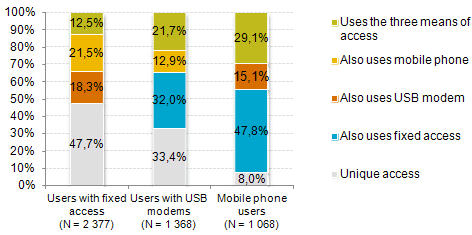About 18.3% of all USB modem (stick) users acquired the service in a service package, 23.0% acquired it from public policy measures promoting access to the Information Society (such as e.Iniciativas), and 58.8% acquired the service independently of these conditions.
About 90% of users with fixed Internet access acquired the service in a service package. ICP-ANACOM's statistical data, provided by the service providers and relating to the first quarter of 2011, indicate that around 80% 1 of fixed Internet access users acquired the service in a service package. These figure are quite high, and result from the growing investment by service providers in service packages, since between 2009 and 2010 the amount of fixed broadband retail offers included in a service package rose from 63% to 80% (ANACOM, 2010a) of all broadband offerings.
The highest rate of respondents with only one means of Internet access occurs among fixed access users. About half (47.7%) of fixed access Internet users only have that type of access, while the figure is about one third in the case of USB modem users, and about 8.0% in the case of mobile phone accesses - suggesting that mobile phone access is mainly used to supplement other means of Internet access - see Figure 4.
Regarding the usage of more than one means of Internet access, in the case of mobile access users, whether via USB modem or by mobile phone, the main combination is achieved with only one fixed access (32.8% in the case of USB modem, and 47.8% in the case of mobile phone access), and there is a lower combination of different types of mobile accesses (12.9% of respondents with USB modem also access the Internet using a mobile phone, and 15.1% of respondents with mobile phone access also access the Internet using a USB modem) - see Figure 4.
Figure 4 - Distribution of respondents by type of Internet access,
and existence of other Internet accesses

Estimate 2: (#) Non-reliable estimate; (*) Reliable estimate; (unmarked) Reliable estimate.
Source: ICP-ANACOM, based on the results of the Survey on the means of access to the Internet.
Among the users where the USB modem was acquired under public policy measures aimed at promoting the Information Society, the share of users that only use that means of access (42.0%) is higher than for USB modem users that acquired that service outside that programme (33.4%). This result suggests that for this group of users access mobility may not have been the main reason for choosing this type of Internet access, but rather the possibility of acquiring it under especial conditions, compared with acquiring Internet outside this programme.
Among the respondents with fixed access there were more users who in addition use a mobile phone access (21.5%) than those with a USB modem access (18.3%) or with the three means of Internet access (12.5%) - see Figure 4. The fact that respondents with fixed Internet prefer the mobile phone over the USB modem as a second access may emphasize the complementarity of this type of usage. The more so when, as previously mentioned, about 90% 3 of respondents with fixed Internet have that service as part of a service package, and currently several providers offer 4 a USB modem with service packages that include fixed Internet.
According to the survey results, about 18.3% of users use the USB modem from a service package, and one in seven of these usually exceed the traffic limit offered by the service provider. It was also found that only about two thirds of the users who were offered a USB modem in a package use it for Internet access. The main reasons stated for not using this access platform were not feeling the need (44.6%), the current access being enough (33.2%), and the USB modem traffic limit (13.4%).
Although these figures are not totally comparable, given the different sample methods 5, the results obtained by Analysys Mason (2011) on the share of respondents who use both a USB modem and a fixed Internet access suggest that the number of respondents with a USB modem that use that access and a fixed Internet access is lower in Portugal than in the above-mentioned countries.
1 Information available at Quarterly reports by servicehttps://www.anacom.pt/render.jsp?categoryId=277884.
2 Estimates were defined according to the corresponding sampling error. Thus, when the sampling error is below 10%, the estimate is considered to be reliable; when the sampling error is between 10% and 25%, it is considered an acceptable estimate, and when the sampling error is above 25%, the estimate is considered not reliable.
3 According to the most recent data received by ICP-ANACOM for the third quarter of 2011, about 80% of customers of the fixed broadband Internet access service acquired the service in a service package.
4 The term ''offer'' results from the fact that service providers offer the USB modem Internet access when the user has already acquired a fixed Internet service, in a package, from that provider. However, contrary to fixed Internet usage, USB modem usage is subject to traffic limits, usually 100 Mbps, the user having to pay for the traffic in excess of this limit.
5 In Analysys Mason (2011) the collection method for the surveys was via Internet, while in the case of Spirituc the survey was carried out by fixed and mobile phone.




